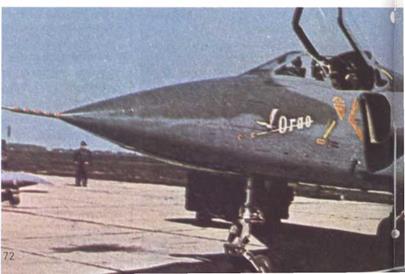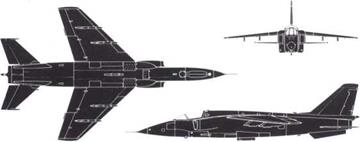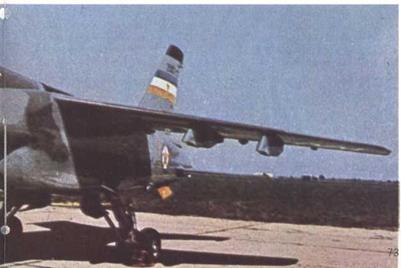JuromVTI/CIAR-93 Orao
VTI-CIAR 93 Orao
Origin: Joint programme by Centrala Industriala Aeronautica Romana, Bucharest, Romania, and Vazduhoplovno-Techniki Institut, Zarkovo, Yugoslavia.
Type: Single-seat tactical attack.
Engines: Two 4,0001b (1814kg) thrust Rolls-Royce/Fiat Viper 632 single-shaft turbojets.
Dimensions: (Estimated) span 24ft 10in (7-56m); length 42ft 4in (12-9m): height 12ft 5in (3-78m).
Weights: (Estimated) empty 9,480lb (4300kg): loaded (fighter mission) 15,8751b (7200kg): maximum loaded 19,8501b (9000kg).
Performance: (Estimated) maximum speed, equivalent to about Mach 0-95 over wide height band (thus, about 700—720mph, 11 50km/h, clean at sea level): maximum speed with weapons, about 550mph (885km/h) at sea level: initial climb (clean) at least 15,000ft (4600m)/min: range on internal fuel (clean, high altitude) about 900 miles (1450km).
Armament: Two Nudelmann-Richter NR-30 30mm cannon, each with 125 rounds: centreline and underwing hardpoints, each reported to be rated at 500kg (maximum total external load, 4,840lb. 2200kg) for wide range of Yugoslav cluster bombs, frag bombs, h. e. and napalm (some retarded), rocket pods (12* 57mm) or photoflashes.
History: Start of design 1971: first flight believed August 1974: official demonstration 15 April 1975: service delivery, probably December 1976. Users: Romania, Yugoslavia.
 |
Development: In 1971 the governments of Romania and Yugoslavia agreed to attempt to meet a common requirement of their air forces for a new tactical combat aircraft by building their own. The decision was specifically aimed to help the two countries become more independent of what had previously been a unique source of military equipment. It is significant that the necessary technical help to carry out what was a most challenging project for the two countries came from the West, especially from the UK (which provides engines and most of the airborne system-hardware, and has probably also assisted with the design and development phases). As no bilateral management organization has been announced observers call the project the "Jurom" (Jugoslavia/Romania), but its correct designation is given above (Orao means eagle).
 |
Above: Three-view of Orao prototype as at first showing in 1975.
The aircraft is intended to fulfil several important roles, especially tactical interdiction, close-air support (with laser ranger) and multi-sensor reconnaissance, A two-seat version is among the development batch of 11 aircraft, and several of these roles are judged to need a second crewmember (despite the payload/range limitation with aircraft of modest power). The two-seater will also fulfil the need for a trainer more advanced than the Soko Galeb. Later it is hoped to produce a fighter version, with afterburning engines and a lightweight multimode radar. From the start the Orao has been planned to operate from unpaved and relatively short airstrips, though the early pre-production machines did not have the expected slats and double-slotted flaps (but they did have a braking chute and soft-field tyres). By 1977 it was reported that all 11 development aircraft had flown (apparently some assembled in each country, but all bearing the joint VTI – CIAR designation) and that production deliveries were about to begin. If the partners achieve their objective of export sales it may enable work to go ahead on a modern air-combat fighter version with a restressed airframe, and possibly canards, twin vertical tails and double-shock variable inlets. There appears to be the potential in this joint effort for long-term competition for both East and West.

Below: The first Orao prototype, which flew in 1974. Since then development has been rather slow, though in 1980 it was believed that two further prototypes and nine pre-production machines (including a dual two-seater) were in the air. No announcement has been made by Rolls-Royce regarding a planned afterburning version of the Viper 632 for production Oraos.










